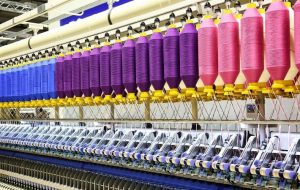
Woolen is one of the oldest textile industries in India. In India, during historical times Woolen textiles were quite popular as a cottage industry. Woolen spinning is done by two types of spinning methods that are ring spinning; which is also used in producing worsted yarns and mule spinning which is only used in the woolen spinning industry. Spinning is the process in which textile fibers and filaments are taken and converted into yarn. For many years people spun natural fibers into yarn with the help of hands.
Weaving is one of the popular ways of fabric manufacturing. It is mainly being done by interlacing two orthogonal sets of yarns in a regular and recurring pattern. The actual weaving process is headed by yarn preparation processes named winding, sizing, drawing, and denting.
Related Videos:- Textile Industry
Whereas, knitting is a process of using long needles to interlink a series of loops made up of one continuous thread. Each knot connects to another one, and once enough loops are being made, it results as a flat piece of material that is called a textile.
Bleaching is commonly carried out to impart whiteness of textile fabrics by removing natural coloring matter. Moreover, the process of dyeing is done to improve the marketability of textile products and to suit the needs of a customer by adding colors.
The four major methods of textile printing are roller, block, screen, and heat transfer printing. In all the methods the application of color generally as a thick paste is done by fixation, usually by steaming or heating, and then by removing excess color by washing.
Market Growth and Trends
The market for Textiles has been growing at a significant rate. Textile manufacturers are demanding raw material like wool yarn. Hence the growing textile industry is a huge influence factor for the yarn market globally. The search for wool yarn with better quality and properties like lightweight and comfort continues to raise the bar, for the manufacturers and sheep farmers, to innovate and develop their presence in the textile industry. Globally the wool yarn industry was valued at around the US $33,500 million in the year 2019 and is anticipated to grow at a CAGR of around 4% in the period of 2019-2029. Increasing disposable income and per capita, consumer spending on clothes and other textiles has rocketed up the consumption of wool yarn.
The textile industry was anticipated to be approx. USD 920 billion in the year 2018, and is expected to see a CAGR of almost 4.4% during the forecasted years to reach USD 1,230 billion by the end of 2024. The industry of textiles is an ever-growing industry, the key competitors are China, the US, and India. China is considered the world’s leading producer and exporter of raw textiles and garments. The US is the leading producer and exporter of raw cotton, while also being the biggest importer of raw textiles and garments.
Moreover, the global knitted fabrics market peaked nearly $55.8 billion of value in the year 2017, at a CAGR of 2.1 %, and is anticipated to reach a CAGR of 4.6% to nearly $66.9 billion by 2022. The bleaching market was valued at USD 692.6 million in the year 2017 and is anticipated to grow at a CAGR of 5.5% from the year 2018 to reach.
Related Projects:- Textile, Apparel, Clothing, Denim wear, Innerwear, Lingerie, Hosiery, Denim Jeans, Readymade Garments and Under Garments Industry.
Conclusion
NIIR project consultancy services (NPCS) gives exclusive information to benefit the new entrepreneurs, research scholars, wool technologists, scientists, if you too want to get the benefit get your hands on the book “Woolen Spinning, Weaving, Knitting, Dyeing, Bleaching and Printing Technology Handbook “ written by NPCS. You can get all the latest information like woolen spinning, atmospheric conditions in wool manufacturing, Bradford system top gilling or top finishing, the principle of weaving, woolen and worsted weaves, etc.
Noo_Art20